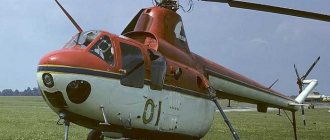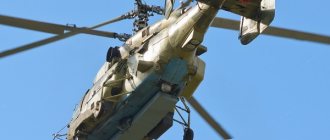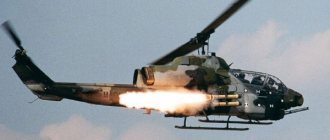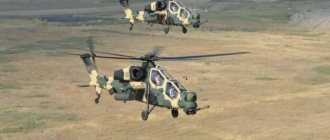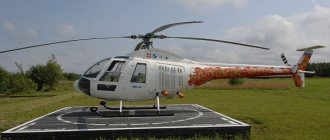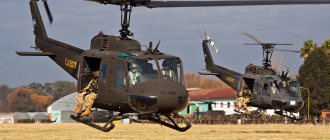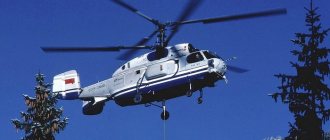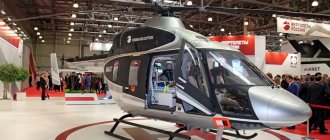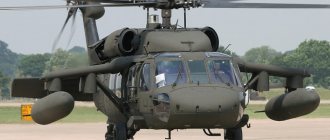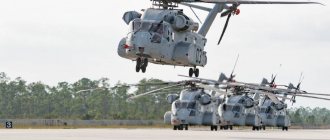DECK HELICOPTER
DECK HELICOPTER
The S-58 helicopter was developed for the US Navy.
The prototype was designated XHSS-1. A Wright R-1820 piston engine with a power of 1525 hp, installed in the forward fuselage, rotated four-blade main and tail rotors. The main rotor and rear fuselage folded for easy storage of helicopters on board the ship
The first prototype of the helicopter took off in March 1954, and on September 20 of the same year, the first production helicopter HSS-1 “Sibat” made its flight, which later received a new designation - SH-34G.
The HSS-1N (SH-34J) modification was equipped with a new navigation system, an autopilot communication unit with an automatic stabilization system and an automatic hovering system.
The HSS-1F (SH-34H) helicopter, built in 1957 in one copy, was equipped with two General Electric T58 theater engines.
In 1960, five HSS-1Z (VH-34D) vehicles entered service with a special detachment for official transportation of VIPs, including the President of the United States.
In addition, modifications of general purpose helicopters with anti-submarine equipment removed were developed, which were designated UH-34G and UH-34J
In 1954, an order was received to develop a modification of the helicopter to transport 12 military personnel. The new vehicles were designated HUS-1 Seahorse (UH-34D).
Four helicopters were modified for use in the Arctic (HUS-1L, or LH-34D).
In addition to the US Navy, Sikorsky helicopters were also ordered by the US Army. Several hundred CH-34A, CH-34B and CH-34C Choctaw helicopters were built, equipped with R-1820-84 engines with a power of 1425 hp. and capable of carrying up to 16 military personnel or 8 stretchers.
This type of machine was widely exported and built under license in France and Great Britain. British versions of these helicopters were produced under its own name "Wessex". These helicopters were already equipped with turbine engines.
In 1971, a helicopter with a RT6A Twin Pak turbine engine was created in the USA, designated S-58T. Until 1981, one hundred and forty-six cars were converted.
The rights to manufacture these helicopters were then sold.
A small number of S-58B and S-58D passenger and cargo transport helicopters were produced.
A total of 1,820 S-58 helicopters of all variants were produced.
In addition, the construction of these helicopters was also carried out by
In particular, the S-58 Heli-Camper helicopter equipped with a Wright Cyclone R-1820-84 engine was produced.
Another modification is the Orlando S-58T, an 18-seat passenger version with nine additional tinted windows located on each side of the cabin.
Helicopter Sikorsky S-58developed for the US Navy.
The prototype was designated XHSS-1
.
The helicopter retained the location of the 1137 kW Wright R-1820 engine in the nose, but it received a new fuselage, four-bladed main and tail rotors, and a different transmission system; The main rotor and rear fuselage folded for easy storage of helicopters on board the ship. , the HSS-1 "Seabat"
, later
the SH-34G,
flew on September 20 .
HSS-1N
(
SH-34J
helicopter was equipped with a Doppler navigation system, an autopilot communications unit with an automatic stabilization system and an automatic hovering system.
The only helicopter, the HSS-1F
(
SH-34H
), flew on January 30, 1957, powered by two General Electric T58 turboshaft engines.
In 1960, five HSS-1Zs
(
VH-34Ds
) joined the VIP transport squadron, including the President of the United States.
Utility Seabat helicopters with anti-submarine equipment removed were designated UH-34G
and
UH-34J
.
October 15, 1954 An order was received for the HUS-1 “Seahorse”
(
UH-34D
) variant - to transport 12 military personnel.
Four HUS-1L
(
LH-34D
) helicopters were modified for Arctic service, and variants with inflatable float landing gear for emergency landing were designated
HUS-1A
(
UH-34E
) and
HUS-1G
(
HH-34F
).
The US Army has ordered several hundred H-34A
,
H-34B
and
H-34C Choctaw
, equipped with 1063 kW R-1820-84 engines and capable of carrying 16 troops or eight stretchers.
This type of machine was widely exported and built under license in France and Great Britain. Westland's turbine-powered helicopters were known as "Wessex"
.
In 1971, the S-58T
with a RT6A Twin Pac turbine engine, converted for the body of the
H-34
.
Until 1981, one hundred and forty-six cars were converted. The rights were sold to California Helicopter International to produce the California Helicopter/Sikorsky S-58T
.
S-58B
and
S-58D
passenger and cargo transport helicopters were produced .
S-58
helicopters of all variants.
In addition to California Helicopter International's options, Orlando Helicopters offers its own. It produced the S-58 “Heli-Camper”
, similar in equipment to
the OHA-S-55 "Heli-Camper"
and powered by a Wright Cyclone R-1820-84 engine.
The next conversion of the Orlando S-58T
was the
Orlando Airliner
, which was an 18-seat passenger version with nine additional tinted windows located on each side of the cabin.
In total, about 30 helicopters were converted. Technical data Sikorsky S-58
Crew: 2
, passengers:
12-18
, power plant:
1 x PD Wright R-1820
power
1137 kW
, main rotor diameter:
17.1 m
, length:
17.3 m
, height:
4.9 m
, take-off weight:
6350 kg
, empty weight:
3754 kg
, maximum speed:
198 km/h
, cruising speed:
158 km/h
, rate of climb:
5.6 m/s
, dynamic ceiling:
2900 m
, flight range:
450 km
Sikorsky "S-58 / UH-34 Sea Horse" helicopter
The multi-role S-58 has found widespread use throughout the world, not only as a means of armed warfare, but also as a unique civilian transport and technological tool. In August 1956, it was officially certified by the American Aviation Registry. Initially, the civilian helicopter bore the official name as an export version of the army H-34A: S-58B. However, it did not take root on civilian vehicles, which later received the designation S-58C (Civil).
The civilian modification differed from the basic N-34, primarily in the interior decoration of the passenger cabin. It was protected by a soundproofing coating and was divided into two salons, similar to a railway compartment. Each compartment had a single door on the starboard side, six soft chairs, three square windows on each side and associated comfort elements.
In another version of the passenger cabin, the seats were located around the perimeter. There was a luggage compartment behind the passenger cabin. To reduce weight, the cabin floor was not reinforced, and the blades and end beam did not fold. There was no rescue winch, but an external sling was provided for each helicopter. Steps were mounted under the entrance doors to facilitate access to the passenger compartment. A civilian modification of the Wright engine was used as the power plant. Many airlines became interested in the civil S-58 long before certification and placed orders in advance. Among the companies are old Sikorsky fans New York Airways and Sabena. They received the first cars in August 1956. This was followed by orders from Los Angeles Airways and Chicago Helicopter Airways. The companies added significant numbers to their helicopter fleets in the 1970s and 1980s as the U.S. and other militaries put retired H-34s on the market. All of them were converted into civilian ones by analogy with the S-58C. Especially many demobilized S-58s were used in oil and gas development areas.
In the 1970s, more than a dozen airlines operated in northern Canada alone, based on Sikorsky rotorcraft. The total number of S-58s in service was about five hundred vehicles. The unique reliability and durability built into the design made it possible to effectively use them for up to 30-40 years, an incredible figure for a helicopter. Sikorsky's rotorcraft have recouped their cost many times over. The S-58 has gone down in history as one of the most economical and efficient helicopters in the world. The story about the civilian applications of Sikorsky’s best helicopter would not be complete without mentioning another tragicomic page in the history of aviation. I. Sikorsky’s main competitor in the heavy helicopter industry, F. Pyasetsky, was forced to leave the company he created in 1955 due to disagreements with the board of directors. He founded a small new company that was developing a number of original projects, including Heli-Stata. Projects of hybrid aircraft combining a balloon and a helicopter were proposed from time to time by inventors in a number of countries, but never left the model stage. Piasecki decided to put this concept into practice. In 1985, he attached four S-58 helicopters received from naval depots to the ZPG airship. The landing gear and rear parts of the fuselage were dismantled from them. The carried away designer neglected the dynamics of multi-screw circuits. During the first take-off on the hybrid, air resonance began. “Heli-Stat” collapsed and burned, burying one of the pilots, and with him the hopes of enthusiasts of this kind of fantastic projects.
The widespread use of the S-58 was also facilitated by the fact that the Sikorsky company encouraged its regular customers. For example, someone who operated an S-58 for three to five years was given free spare parts worth 25% of the total cost of the helicopter. The special firefighting version of the S-58 carried 1.5 tons of defoaming solution, which was sprayed from the air. The powerful inductive flow under the main rotor greatly facilitated this process.
The widespread use of the S-58 was also facilitated by the fact that the Sikorsky company encouraged its regular customers. For example, someone who operated an S-58 for three to five years was given free spare parts worth 25% of the total cost of the helicopter. The special firefighting version of the S-58 carried 1.5 tons of defoaming solution, which was sprayed from the air. The powerful inductive flow under the main rotor greatly facilitated this process.
Following the S-58 fleet, the US ground forces also became interested. Its characteristics, in the best possible way, met the requirements of the army command for helicopters. Initially, army aviation was interested in the Pyasetsky PV-22 (N-21), but after identifying the disadvantages characteristic of the longitudinal design, the military reduced purchases of the PV-22 and preferred the S-58. The 58th had the same Wright R-1820 engine as the PV-22, but had better performance characteristics. In 1956, the S-58 set three world speed records in one flight: along a closed route at a base of 100 km - 228.36 km/h, at a base of 500 km - 218.87 km/h and at 1000 km - 213.4 km/h Since 1954, 434 helicopters have been supplied to army aviation under the designation H-34A Chocktaw (name of an Indian tribe). Another 23 of the same vehicles were converted from UH-34Ds transferred to the Army by the Navy Marine Corps.
The cargo-passenger cabin could accommodate up to 18 equipped soldiers or 8 wounded on stretchers. In terms of weight characteristics, the N-34A corresponded to the Mi-4, but, unlike the Soviet machine, it did not have a cargo hatch and ramp, which limited the dimensions of the cargo transported. Large loads up to 2200 kg were transported on an external sling, for observation of which there was a glazed window in the floor.
In 1956, an automatic stabilization system was tested on the S-58, which eliminated the swing of the load. To lift smaller loads and for rescue operations, the Choctaw retained the cargo winch from Sibet. To make it easier to work with, a retractable step was installed under the fuselage doorway. Since a shorter range was required for an army helicopter, the capacity of the N-34A's front fuel tank was reduced. Choctaw fuel tanks were protected.
The H-34A Choctaw was also used for reconnaissance, training and aerial surveillance, becoming the main helicopter of the ground forces. Although the only place where the Americans used the Choctaw was a small landing operation in Lebanon in 1958, it was there that they “tested out” the tactics of using army aviation. In September 1962, the N-34A received the designation CH-34A. Since all N-34As were supplied to American troops located in Europe (only Pyasetsky N-21 helicopters were sent to the Far Eastern garrisons of the US Army), their army aviation did not use them in Vietnam, but for a long time they formed the basis of the helicopter units of the South Vietnamese Air Force. The first 30 copies arrived in 1959. The N-34A and N-34C transferred under the military assistance program (more on that later) equipped seven South Vietnamese helicopter squadrons.
The Canadian Air Force made extensive use of its six Choctaws. They were used for transport and search and rescue operations, during the creation of an early warning and air defense surveillance system in the north of the country. Several N-34As were operated in Uruguay, Nicaragua, China, Haiti and Israel. The French Air Force purchased 117 Choctaws and used them effectively in combat operations in Algeria. Under license, another 98 vehicles, called “Mammoth,” were built at the Sud-Est plant. On two of them, the French replaced the Wright piston with two Turbomeka and Bastan gas turbines.
26 “Choctaw” received by the Bundeswehr. The West Germans called their vehicles H-34G.I. Another 25 Choctaw H-34G.II were delivered to them in the search and rescue version. In the US ground forces, such helicopters, converted from the H-34A by installing additional search and rescue equipment, were designated H-34B, and since 1962 - CH-34B. In the late 1950s and early 1960s, the US Army Aviation modernized its Choctaws into the H-34C variant (from 1962 CH-34C). It featured more advanced flight and navigation equipment, which ensured round-the-clock operation of rotorcraft. At least 190 N-34s were converted. Some of them entered the Air Forces of South Vietnam and Thailand.
The third potential customer for rotorcraft in the US armed forces, the Navy Marine Corps, was slightly delayed in finalizing the contract for the S-58. The fact is that the Corps command, based on the experience of combat operations in Korea, demanded that the developers of an air assault helicopter have significantly greater payload and capacity than the S-58, and preferred to support, first of all, the S-56 program. The Marines returned to the concept of a medium assault helicopter, intermediate in class between the S-55 and S-56, only in 1956.
The excellent reviews of the US Navy and Army commands about the S-58 determined the choice of the Marine Corps headquarters. Since 1957, the HUS-1 Seahorse began to enter service with the air assault squadrons of the Corps. In September 1962 they received the designation UH-34D. The Seahorses were practically no different in design from the army amphibious transport H-34A (CH-34A) Choctaw, with the exception of equipment and small details associated with the specifics and traditions of the Marine Corps service. In total, Sikorsky Aircraft built 640 Seahorses - a third of the S-58 production.
The UH-34D air assault aircraft were used in all military operations conducted by the US Marine Corps in the 1960s. Unlike its army counterpart, the UH-34D was intensively used by the Americans during the Vietnam War, where it replaced the army N-21 Piasecki, which turned out to be of little use. Marine squadron HMM-362 became the first American S-58 unit deployed to Vietnam. During the first four months of fighting, the squadron flew 15,200 sorties, landed 25 thousand soldiers and transported 59 thousand passengers.
In the year of the escalation of the war in Vietnam, in 1965, there were already six squadrons of American Marines from 24 Seahorses. The Sikorsky helicopter remained a “hard worker” until the second half of the 1960s, when it began to be rapidly replaced by the gas turbine UH-46 Sicknight and UH-1 Iroquois. Not a single combat operation could take place without the UH-34D. They were used for landing tactical landings and reconnaissance and sabotage groups, reconnaissance and surveillance, supplying remote and surrounded garrisons, evacuating sick and wounded, searching and rescuing crews of downed aircraft and helicopters, evacuating people and damaged equipment, and training crews. The Seahorses used in reconnaissance and observation squadrons were unofficially designated OH-34D, while those used for search and rescue purposes were designated HH-34D. Three dozen UH-34Ds were transferred from the Marine Corps to special units of the CIA and military intelligence. The US Marine Corps transferred at least 70 Seahorses to the South Vietnamese Air Force squadrons, where they were successfully operated along with the former American army CH-34A and CH-34C. In addition, six UH-34Ds entered service with the Philippine Air Force, two with the Cambodian Air Force and one with the Dutch Navy.
The S-58 proved to be significantly more reliable and less vulnerable than all other rotary-wing aircraft used in the initial stages of the Vietnam War. Their durability was legendary. At the same time, American helicopter pilots, like their colleagues from France, quickly became convinced of the need for armament and armor for the S-58. Machine guns of various calibers began to be installed on turrets in door and window openings, as well as stationary on consoles on the sides of the fuselage. Then NAR units joined them. The experiments still included options for arming the Seahorses with cannons and guided missiles.
Steel sheet pallets were mounted under the most vulnerable and most often damaged place - the forward engine compartment of the fuselage. The cockpit was also armored. Helicopter pilots were the first to receive body armor. They really needed them, since military operations revealed an important drawback of the S-58 layout, which was an advantage in peacetime conditions - the high location of the cockpit. During landing operations they received the bulk of the lead. The fighting in Vietnam forced another amusing modification to be made to the design of the airborne S-58s - a step under the cargo-passenger cabin door. Without it, it was difficult for the short Vietnamese paratroopers, who were also loaded with ammunition, to climb into the cabin.
In addition to military operations, Marine UH-34Ds have been used successfully throughout the world in search and rescue missions and evacuations from natural disaster areas. On May 5, 1961, it was the Seahorse crew who found and delivered to the aircraft carrier, along with the capsule, the first American astronaut Alan Shepard, who splashed down in the ocean. In peaceful life, Marine UH-34Ds transported people and cargo, delivered food, unloaded ships, fought forest fires, mosquito and locust infestations, and were used for crane installation work.
Forty Seahorses were converted in the late 1950s into the HUS-1A amphibian (from 1962 UH-34E). They were intended for landing and search and rescue operations in areas with long expanses of water and had inflatable floats on a standard wheeled chassis - “donuts”, a suspended side fuel tank, windows, blisters and sound-absorbing coatings in the cargo-passenger cabin.
Three of them received special equipment for flying at night and were designated HUS-1AN. Another four HUS-1A were converted into a special polar modification HUS-1L (from 1962 LH-34D): insulated and equipped with all-weather navigation equipment similar to that installed on the anti-submarine HSS-1N. Polar Seahorses were used at Antarctic stations in the United States.
| Modification | CH-34A |
| Main screw diameter, m | 17.07 |
| Tail rotor diameter, m | 2 .90 |
| Length, m | 14.25 |
| Height, m | 4.85 |
| Weight, kg | |
| empty | 3513 |
| normal takeoff | 5897 |
| maximum takeoff | 6350 |
| Internal fuel, l | 1160 + optional 568 |
| engine's type | 1 PD Wright R-1820-84B/D |
| power, kWt | 1 x 1137 |
| Maximum speed, km/h | 196 |
| Cruising speed, km/h | 156 |
| Range, km | 397 |
| Rate of climb, m/min | 335 |
| Practical ceiling, m | 2895 |
| Static ceiling, m | 1490 |
| Crew, people | 2 |
| Payload: | 18 passengers or 8 stretchers |
